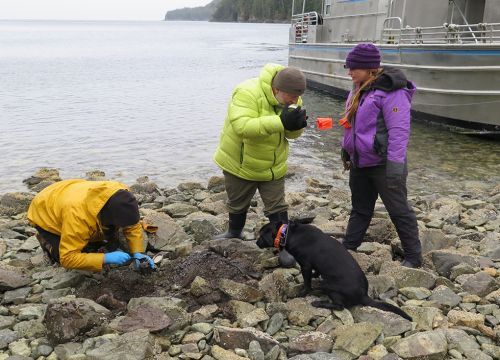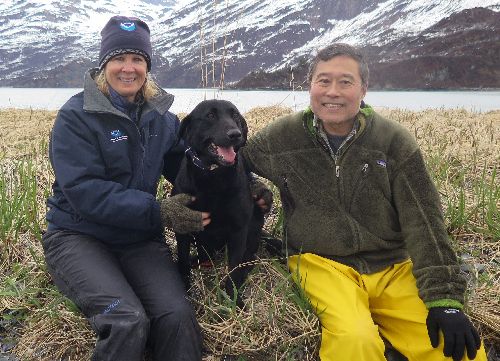Using Dogs to Find Oil During Spill Response
May 8, 2017 - NOAA’s Office of Response and Restoration’s Emergency Response Division returned to Prince William Sound to use some of the old buried oil from the Exxon Valdez oil spill to improve how we can find oil on the shoreline in the future. This time, the key player was an enthusiastic black Labrador retriever named Pepper.
This project was to validate and better understand the capabilities of trained oil detection canines to locate and delineate subsurface stranded oil. The results of the study have a high probability of immediate, short-term applications and long-term real benefits in the design and implementation of shoreline cleanup assessment technique surveys for stranded oil.
Usually, teams of people trained in the shoreline assessment cleanup techniques, called SCAT, comb for oil buried along shorelines and other areas affected by oil spills. The technique has been an integral part of oil spill response since the Exxon Valdez spill in 1989. It is a systematic approach to describing the “where” and “how much” for spilled oil, and directs cleanup activities during moderate and larger spill incidents.
The SCAT process is labor-intensive and time-consuming, and requires trained personnel to survey areas possibly impacted by an oil spill. In certain habitats—like gravel or sand beaches—oil either penetrates deeply below the surface or becomes buried by material deposited on top, making oil assessment even more difficult. In these cases, SCAT teams must dig pits to determine the existence and extent of buried oil that would require excavation and other more complicated cleanup approaches. The limitations of human-centric SCAT surveys led one of the originators of the first SCAT programs during Exxon Valdez, Ed Owens of Owens Coastal Consultants, to begin discussions with Paul Bunker’s K2 Solutions to determine if the high sensitivity, accuracy and precision of canine noses could be adapted and applied to the task of oil spill shoreline assessment.
This is what led Ed, Paul, Pepper the black lab, her handler Haiden Montgomery, and a host of interested observers from NOAA, the Coast Guard, Exxon-Mobil, Chevron, Polaris Environmental, and the Oil Spill Recovery Institute to make the trip to Prince William Sound, the Alaskan region impacted by Exxon Valdez. The Oil Spill Recovery Institute sponsored the project. Dog teams are already being productively employed for oil assessment in actual spills (Pepper will be traveling to Canada to join her canine colleagues for a river spill assessment).
Scientists from the Office of Response and Restoration observed the trials, assisted in the verification of oil presence, and provided feedback on the use of oil detection dogs in real-time spill situations. Canine detection of buried oil holds real promise for improving the effectiveness and efficiency of oil spill assessment surveys. The methodology will continue to be refined and improved as it is used in real oil spill situations, and as we increase our understanding of how and what the dogs are actually detecting.
Gary Shigenaka and Catherine Berg with the Office of Response and Restoration contributed to this article.
 An official website of the United States government.
An official website of the United States government.


